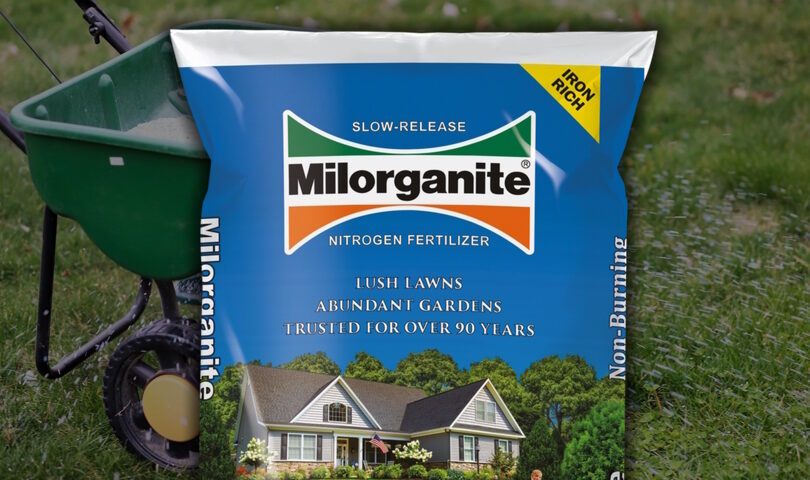For nearly a century, homeowners have used Milorganite to deliver the nitrogen their lawns crave without the risk of burning their grass or creating patchy, streaky results. That’s because Milorganite releases nitrogen more slowly than many other fertilizers, keeping grass consistently nourished while it grows strong and resilient. Milorganite also contains iron, which helps grass develop deeper, richer shades of green.
Its unique properties mean that Milorganite should be applied on a specific schedule for best results. Apply it too early, and you’ll waste some of your investment; add it too late, and its slow-release formulation might not give your grass everything it needs. This article will take a close look at Milorganite before discussing the recommended application schedules for most lawns in the continental US.
What is Milorganite?
Milorganite is a slow-release nitrogen fertilizer and one of the oldest branded fertilizers on the market. And it all started at a water-treatment facility.
Back in 1926, wastewater treatment used many of the methods we still employ today, most of them centered around the idea of microbes doing a large part of the job by eating organic matter found in the water supply. That was enough to prepare water for reintroduction to natural biomes, but it left a slurry composed mostly of billions of nitrogen-rich microorganisms.
The Milwaukee Metropolitan Sewerage District decided that instead of tossing these microbes into nearby landfills, they would dry them, process them, and bag them as a natural source of nitrogen fertilizer. MILwaukee ORGAnic NITrogen was born.
Milorganite contains 6% nitrogen, 4% phosphorous, and a trace amount of potassium. It also contains 2.5% iron, along with a wide array of micronutrients.
Milorganite as a Lawn Fertilizer
As long as your soil’s temperature and hydration stay within a certain range, Milorganite breaks down at a predictable rate, slowly releasing nutrients over the course of eight to ten weeks. This slow, steady approach helps avoid overfertilizing your lawn, and it goes a long way toward preventing fertilizer run-off. Speaking of which, the iron found in Milorganite is non-staining, meaning that even if your lawn drains onto your driveway and sidewalks, it won’t produce rust stains. Because it is an organic product, Milorganite’s non-active components help condition the soil and improve its ability to retain moisture.
Applying Milorganite: When, How, and How Much
For all its benefits, Milorganite is a bit picky about when and how it is applied. More aggressive fertilizers are a bit more forgiving in this respect: add them, and you’ll get quick, predictable results for a relatively short time. Here is a brief guide to getting the most out of each Milorganite application.
When to Apply Milorganite
As a rule of thumb, you can tie your application of Milorganite to the holiday calendar.
In the northern US, aim for these dates:
- Memorial Day
- Independence Day
- Labor Day
- Thanksgiving (between your lawn’s dormancy and the first frost)
In the southern US, this schedule works best:
- Easter
- Memorial Day
- Labor Day
- Columbus Day (or when you overseed, typically around early October in most regions)
Wherever you live, one thing is constant: if you can only fertilize once a year, make it autumn.
How Much Milorganite to Put Down
In all climates and for all varieties of grass, the recommended application rate is 32 pounds of Milorganite for every 2,500 square feet. Conveniently enough, Milorganite comes in 32-pound bags.
This rate is subject to state and local regulations, some of which are tied to the concentration of nitrogen found in a given fertilizer. In Maryland, for example, you must spread one bag of Milorganite across 5,200 square feet—more than double the typical area.
How to Apply Milorganite
Milorganite does not self-spread. Always use a broadcast spreader or drop spreader to help distribute fertilizer evenly across your lawn, and allow for an inch or two of overlap between rows.
Tips for Getting the Most Out of Milorganite
While it likes to stick to a firm schedule, Milorganite is no more difficult to apply than other solid fertilizers. Here are some tips for getting even more out of each application.
- Mow your lawn before applying Milorganite to help each grain reach the soil.
- Take a moment to calibrate your spreader using Milorganite’s own guide.
- Be sure to walk at a steady rate while spreading Milorganite. Walking more briskly might seem like a way to get the job done faster, but it also spreads less fertilizer as you go.
- For more even application, apply half of each row’s amount of Milorganite while walking in one direction, and the other half while retracing your steps.
- You don’t need to water in Milorganite like you do with most synthetic fertilizers. Do be sure that your lawn gets a healthy drink of water shortly after fertilizing, though, since Milorganite only begins to release nutrients once it is moistened.

